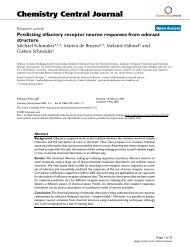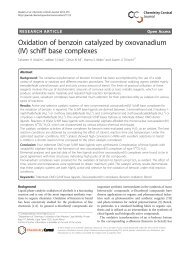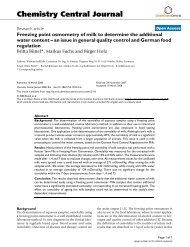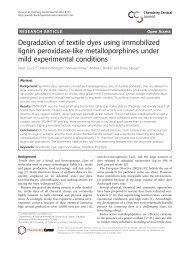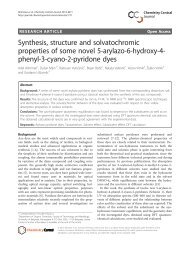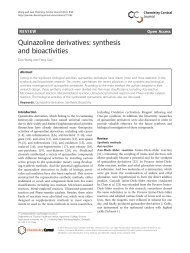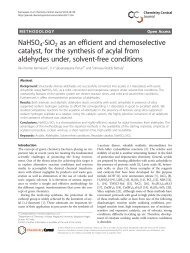Development and validation of stability indicating method for ...
Development and validation of stability indicating method for ...
Development and validation of stability indicating method for ...
You also want an ePaper? Increase the reach of your titles
YUMPU automatically turns print PDFs into web optimized ePapers that Google loves.
Walash et al. Chemistry Central Journal 2011, 5:61<br />
http://journal.chemistrycentral.com/content/5/1/61<br />
Page 9 <strong>of</strong> 11<br />
Table 4 Application <strong>of</strong> the proposed spectr<strong>of</strong>luorimetric <strong>method</strong> to the determination <strong>of</strong> SER in spiked human plasma.<br />
Sample Amount added (μg/mL) Amount found (μg/mL) % Recovery<br />
1-Plasma (intra-day precision)<br />
0.2 0.209 104.50<br />
0.25 0.242 96.80<br />
0.30 0.295 98.33<br />
0.35 0.347 99.14<br />
0.40 0.407 101.75<br />
Mean ± SD 100.10<br />
3.04<br />
2-Plasma (inter-day precision) 0.30 0.270 90.00<br />
0.30 0.270 90.00<br />
0.30 0.280 93.33<br />
Mean ± SD 91.11<br />
1.92<br />
N.B.:<br />
Each result is the average <strong>of</strong> three separate determinations.<br />
stable under <strong>for</strong>ced alkaline, acidic or photolytic degradation<br />
conditions as revealed from the constant absorbance<br />
values <strong>of</strong> samples treated with concentrated solutions <strong>of</strong><br />
NaOH or HCl <strong>and</strong> UV-light.<br />
A .<br />
Log A<br />
-0.1<br />
-0.2<br />
-0.3<br />
-0.4<br />
-0.5<br />
-0.6<br />
-4.00 -3.75 -3.50 -3.25 -3.00 -2.75<br />
Log [NBD-Cl]<br />
Oxidative degradation studies<br />
Degradation kinetics study<br />
For the kinetic study, 0.1% (v/v) <strong>of</strong> hydrogen peroxide was<br />
used <strong>for</strong> the oxidative degradation <strong>of</strong> the drug. The degradation<br />
was found to follow first order kinetics <strong>and</strong> to be<br />
temperature dependent (Figure 10). The apparent first<br />
order degradation rate constant (K obs )<strong>and</strong>thehalflife<br />
time (t 1/2 ) at each temperature were calculated (Table 5).<br />
Plotting log K obs values versus 1/T, the Arrhenius plot was<br />
obtained (Figure 11). The activation energy was calculated<br />
<strong>and</strong> found to be 6.38 k.Cal.Mol -1 .<br />
The tolerance limit (concentration <strong>of</strong> interfering substance<br />
causing 3.0% relative error) <strong>of</strong> the degradation product<br />
was measured after mixing increasing concentrations<br />
<strong>of</strong> the degradation product with 10 μg/mL pure SER. The<br />
tolerance limit was found to be 20%, i.e. up to 20% from<br />
the degradation product will not cause interference in the<br />
proposed spectrophotometric <strong>method</strong> (Table 6).<br />
B .<br />
-0.25<br />
Pathway <strong>of</strong> degradation<br />
By analogy to previous report [28] discussing the degradation<br />
<strong>of</strong> isradipine (containing secondary amino group)<br />
by hydrogen peroxide, it is suggested that the<br />
Log A<br />
-0.50<br />
-0.75<br />
-1.00<br />
0.0 0.5 1.0 1.5<br />
Log [sertraline]<br />
Figure 9 Limiting logarithmic plots <strong>for</strong> the molar reactivity <strong>of</strong><br />
SER with NBD-Cl. (A) log A vs log [NBD-Cl]. (B) log A vs log [SER].<br />
Scheme 1 Proposed reaction pathway between NBD-Cl <strong>and</strong><br />
sertraline.





